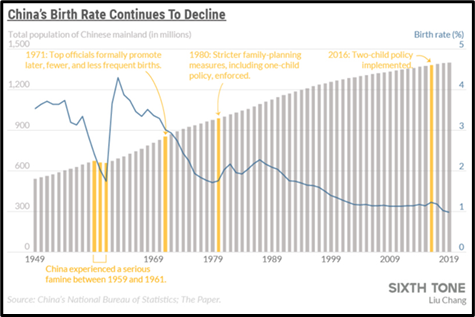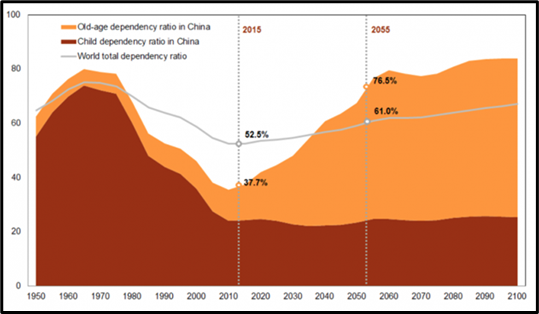By: Elizabeth Chen
A new study published February 8 by the Ministry of Public Security of the People’s Republic of China (PRC) (MPS, 中华人民共和国公安部, zhonghua renmin gongheguo gongan bu) reported that there were 10.035 million registered births in 2020, down from 11.79 million in 2019. This represents a 15 percent decrease following the coronavirus pandemic (Guancha.cn, February 8). Although the number of registered births—that is, newborns recorded in the household registration hukou (户口) system—is not the same as China’s official birth rate, the decline has concerned analysts that a long-forewarned demographic crisis may be approaching faster than expected.National birth and population figures for the previous year are usually released in January but have been delayed until April this year as China’s National Bureau of Statistics (NBS) compiles its decennial census. In the meantime, data released by some provinces and cities in January has appeared to confirm the implications of the MPS study. Data released from the capital city of Guangdong province—which saw the highest number of births per province in 2019—showed that birth rates in Guangzhou were down by 17 percent year-on-year and mirrored broader trends across the rest of the province. In Zhejiang, China’s wealthiest province, the cities of Wenzhou and Taizhou reported that new births in 2020 fell by 19 percent and 33 percent respectively compared to 2019 (SCMP, February 2).
These statistics belayed earlier optimism that the pandemic could have fueled a ‘quarantine baby boom’ that would have helped offset years of birth rate decline (CGTN, October 29, 2020, Yicai, January 31). And although China was the only major economy to experience GDP growth last year, the demographic data has sharply exposed the fragility of its recovery from COVID-19 as well as underscoring long-term weaknesses in its labor market that bode poorly for future development.
Entering the “Low Fertility Trap”
Even before the pandemic, official statistics showed that China’s birth rate had declined for three years. In 2019, NBS reported that the total number of new births was 14.65 million, which was itself the lowest number seen since 1961. It is plausible that the total number of births in 2020 will be the lowest on record since China became a nation-state in 1949. Independent analysts have argued that the situation may be even more severe that official numbers indicate and that the 2015 reform of national family planning policy did little to ameliorate ongoing factors contributing to birth rate decline, including high costs of childcare; a serious demographic contraction following the implementation of the One Child policy in 1980 and ongoing efforts to repress ethnic minorities stunting population growth in lower-income western regions (China Brief, February 28, 2020; Jamestown Foundation, July 21, 2020).
Experts worry that China may have fallen into the so-called “low fertility trap,” in which self-reinforcing mechanisms lead to continuous birth decline (SCMP, February 9). Demographers generally hold that the replacement level fertility rate—defined as the average number of children born per woman—necessary to sustain existing population levels should be about 2.1. But the World Bank has pegged China’s fertility rate at under 1.7 since 1995 (World Bank, accessed February 9). Although positive migration has allowed China’s total population to continue growing thus far, a report by the state-affiliated Chinese Academy of Social Sciences (中国社会科学院, zhongguo shehui kexueyuan) estimated that China will begin to see negative population growth as early as 2027 (CASS, January 4, 2019). More pessimistic analysis by the Evergrande Research Institute (恒大研究院, hengda yanjiuyuan) has predicted that negative growth will begin during the 14th Five Year Plan (2021-2025) (FYP) (Yicai, February 3). Even the most conservative experts have begun to signal their concerns about these population changes: in December, the president of the China Population Association (专访中国人口学会, zhuanfang zhongguo renkou xuehui) said in an interview that the national family planning policy should be changed and the population be allowed to make their own decisions regarding childbirth during the 14th FYP (Jiemian News, December 15, 2020).  Image: A graph created by Sixth Tone shows the impact of national family planning policies on China’s birth rate and population growth since the nation’s founding in 1949 (Image source: Sixth Tone).
Image: A graph created by Sixth Tone shows the impact of national family planning policies on China’s birth rate and population growth since the nation’s founding in 1949 (Image source: Sixth Tone).
 Image: A graph created by Sixth Tone shows the impact of national family planning policies on China’s birth rate and population growth since the nation’s founding in 1949 (Image source: Sixth Tone).
Image: A graph created by Sixth Tone shows the impact of national family planning policies on China’s birth rate and population growth since the nation’s founding in 1949 (Image source: Sixth Tone).A Silver Wave
China’s birth rate crisis has been paralleled by the simultaneous and related problem of a rapidly aging population. According to a report by the Ministry of Civil Affairs (MCA, 中华人民共和国民政部, zhonghua renmin gongheguo minzhengbu), the number of people over the age of 65 in China will hit 300 million during the 14th FYP (The Paper, October 23, 2020). A more pessimistic projection by the Evergrande Research Institute suggests that China will become an aged society—defined by the UN as a society in which more than 14.3 percent of the country’s population is over the age of 65—by 2022 (Evergrande, accessed February 11).
Declining birth rates and an increasing elderly population are expected to put pressures on China’s working age population (defined as the population between the ages of 15 to 64) from both sides. UN population projections anticipate that China’s working age population will fall by 200 million by 2050. The dependency ratio (defined as the ratio of the population over 65 to the population aged 15-64), which began rising in 2011 after a 30 year decline, is projected to increase rapidly to 75 percent by 2055 (CASS, January 4, 2019) (see graph below). Based on current estimates, it is likely that China will have an aged society before it becomes a high-income country. In other words, China faces the problem of “becoming old without becoming rich” (未富先老, weifu xianlao) (Yicai, February 3). Image: UN data from 2017 shows China’s dependency ratio has begun rising after a 30 year decline that ended in 2011. The dependency ratio broadly measures pressures on the working class population, which bears broad implications for policymakers (Image source: Unicef).
Image: UN data from 2017 shows China’s dependency ratio has begun rising after a 30 year decline that ended in 2011. The dependency ratio broadly measures pressures on the working class population, which bears broad implications for policymakers (Image source: Unicef).
 Image: UN data from 2017 shows China’s dependency ratio has begun rising after a 30 year decline that ended in 2011. The dependency ratio broadly measures pressures on the working class population, which bears broad implications for policymakers (Image source: Unicef).
Image: UN data from 2017 shows China’s dependency ratio has begun rising after a 30 year decline that ended in 2011. The dependency ratio broadly measures pressures on the working class population, which bears broad implications for policymakers (Image source: Unicef).Added to this is the fact that social security reforms—already lagging behind the pace of demographic changes—have been hard hit by the pandemic. A 2019 study by the Chinese Academy of Social Science found that the main state pension fund was expected to run out of money by 2035, with the projected gap between contributions and outlays rising after 2027 (SCMP, April 12, 2019). As part of policies to drive economic recovery after nationwide shutdowns aimed at controlling the COVID-19 outbreak early last year, the central government announced that businesses could reduce or stop contributions to already under-financed provincial pension and insurance funds during the first half of 2020. In response, one expert warned that “there is [already] a massive gap which is unsustainable” (SCMP, April 7, 2020).
Signals Ahead of the 14th FYP
Because maintaining stability is intrinsically tied to the legitimacy of the ruling Chinese Communist Party (CCP), the Chinese state has prioritized social reforms ahead of the 14th FYP (The Paper, October 23, 2020). Following the Fifth Plenum, which took place from October 26-29, 2020, the CCP Central Committee released its “Proposals for Formulating the 14th Five-Year Plan for National Economic and Social Development and the Long-term Goals for 2035” (中共中央关于制定国民经济和社会发展第⼗四个五年规划和⼆〇三五年远景⽬标的建议, zhonggong zhongyang guanyu zhiding guomin jingji he shehui fazhan di shisi ge wunian guihua he erlingsanwu nian yuanjing mubiao de jianyi) (Gov.cn, November 3, 2020). These proposals can be understood as a general and detailed outline of the 14th FYP, the full version of which is expected to be published sometime in March.
The outline for the 14th FYP included the need to “optimize the birth policy and improve prenatal and postnatal care and services…[to] promote long-term balanced population development” (Yicai, December 1, 2020). The proposals also included prescriptions to “gradually” delay the national retirement age and “develop the silver economy” (发展银发经济, fazhan yinfa jingji), signaling the central government’s plans to leverage the productive capacity of China’s 65+ population as a means of offsetting pressures on the traditional working-age population. Raising the retirement age (currently mandated at 60 for men and 55 for women) was proposed ahead of the 13th FYP (2016-2020) but not officially included in the plan. Following the Fifth Plenum, there has been a notable propaganda push to revisit retirement reforms (Xinhua, December 14, 2020; China Daily, December 22, 2020). Despite consistent public opposition, it now seems likely that such reforms will be included in the next five-year plan (SupChina, November 11, 2020).
Conclusion
Birth rates tend to plummet during periods of economic uncertainty and instability, and despite China’s comparatively strong recovery from the COVID-19 pandemic, the decline in registered births throughout 2020 sends a strong signal that its people remain uncertain about the future. Although more complete analyses of China’s demographics will have to wait for the publication of census data in April, it seems that the once-in-a-lifetime pandemic has exacerbated existing population pressures such as birth declines and an aging population. These trends will bear major implications for key strategies such as dual circulation and rural-urban revitalization, which have been aggressively pushed by Chinese President Xi Jinping as a means for driving economic development and reaching a goal to “basically achieve socialist modernization” by 2035. The reform of national family planning policies, labor regulations, health care and the social security system will be crucial for maintaining stability amid rapid demographic changes in the coming years.
Elizabeth Chen is the editor of China Brief. For any comments, queries, or submissions, feel free to reach out to her at: cbeditor@jamestown.org.
No comments:
Post a Comment